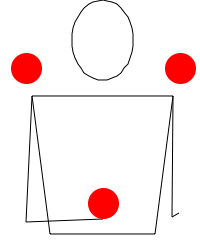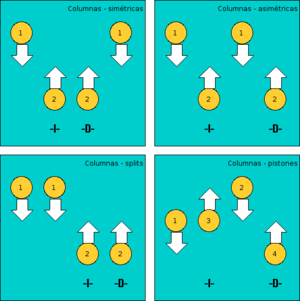Columns (juggling) facts for kids
 |
|
| Minimum prop #: 3 | |
| Difficulty: 3/10, 3.7 (note: difficulty ratings are arbitrary and subject to change) | |
| Siteswap: (4,4)(4,0) | |
| Shannon: 4 | |
| Period: 4 | |
| Parity: even or odd | |
| Notes: asymmetrical, synchronous or asynchronous |
Columns is a fun juggling trick where you throw the balls straight up and down. It's also called One-up Two-up. Unlike other juggling patterns where balls move sideways, in Columns, they stay in their own vertical paths.
The most common way to do Columns is with three balls. Imagine two balls going up at the same time on the sides, and then one ball going up in the middle. To do this, you might juggle two balls in one hand and one ball in the other. The hand with two balls moves faster, while the other hand stays mostly still. You can switch which hand juggles the middle ball to make the pattern look balanced.
Contents
Cool Columns Variations
There are many ways to change up the basic Columns trick. These variations make the pattern look different and more exciting!
Two-in-One Columns
The Two-in-One is a simpler version of Columns. You only use one hand to juggle two balls. These two balls go straight up and down in their own paths. Columns is like doing a Two-in-One with one hand, and then adding a third ball thrown at the same time from your other hand.
Moving the Middle Ball
The single "lone" ball in the middle can be moved around. You can throw it at a slight angle or move your hand when you catch it. This changes its position compared to the other two balls. You can even throw this middle ball quickly from one hand to the other, similar to how a box pattern works, while the other two balls are still in the air.
Crossing the Outside Balls
The two balls that go up at the same time can also be changed. You can cross them over in the air so they don't land in the hand that threw them. Your hands can also cross or uncross during the trick.
The Dummy and Yo-yo Columns
A cool variation is to carry one of the two outside balls up and down instead of throwing it. This is called the Dummy pattern, or sometimes "fake columns." It's like adding a "carry" move to the hand that would normally throw the lone ball in a Two-in-One. You just hold one ball and move it up and down.
In a special version called Yo-yo (or The String), you carry the ball directly above one of the other juggling balls. This makes it look like the balls are connected by an invisible string, just like a yo-yo toy!
You can do Columns with more than three balls. You can also throw the balls at the same time (synchronous) or one after the other (asynchronous). You can even use different juggling props like clubs or rings!




